Dryopteris (aka wood ferns or male ferns) represent the largest group of garden-worthy ferns. The genus has a cosmopolitan range with perhaps as many as 400 species that are usually found in woodland habitats. Dryopteris are especially speciose in eastern Asia and the Himalayas. The name Dryopteris, is derived from the Greek, drys, "oak" and pteris, "fern", "fern of the oak woods".
This is the largest genus within the family Dryopteridaceae and is closely related to Polystichum and Arachniodes. The family is fairly easy to identify by the shaggy scales on the bases of the stipes (fern leaf stems). Though not the only fern family to display this trait, if you find it, odds are you’re looking at a plant in this family. Compared to Polystichum, these ferns have wider and often more-divided fronds. The sori (clusters of spores) generally appear as “round” dots on the backs of the leaves, in some they are close to the margin of the pinnules in others more centrally located. In similar ferns such as Lady Ferns (Athyrium) the sori are in elongate clusters (lines) and help to quickly differentiate the two groups if fertile material is available.
Wood ferns are invaluable structural and textural elements in the woodland garden. They are generally very well-behaved, slowly forming clumps and their medium to large size make them prominent among other, lower growing plants. Many species are very easy to grow in rich, highly organic soils and there are a seemingly endless number of evergreen and deciduous forms, sizes, and textures to include in your garden.
Dryopteris affinis ssp. affinis
Garden-worthy Dryopteris Varieties
Dryopteris affinis ssp. affinis (Golden Scaled Male Fern)
This is perhaps the most widely cultivated species worldwide, though we see far less of them in the Southeast than in the Pacific Northwest or Europe. There have been a seemingly endless number of selections of crested forms and other mutations. It would be easy to fill a woodland garden with nothing but the many selections that have been developed. In our garden, the golden scaled male fern proved to be adaptable and tolerant of our climate, if kept moist during dry times and planted in cooler microsites. The nice-sized, semi-evergreen foliage of gold-scaled male fern holds until it simply falls apart in early spring. Clumps to 2' tall by 2' wide make nice specimens or mass plantings against a wide variety of other woodland inhabitants. Dryopteris affinis is equally at home in either acidic or alkaline soils. In West Coast gardens, these ferns, particularly the crested forms, attract large numbers of leafhopper pests. (Zones 4a-8b)
Dryopteris affinis 'The King'
Dryopteris affinis 'The King' (The King Gold Scaled Male Fern)
This remnant from England's Victorian fern craze makes a superb garden specimen to 30" tall by 30" wide. The broad, semi-evergreen, rich green fronds boast petticoats on the end of each pinnae and the end of each frond. Regardless of its predilection for cross-dressing, Dryopteris 'The King' is a great specimen plant for that prized spot in the woodland garden. (Zones 4a-8b)
Dryopteris arguta (Western Wood Fern)
This denizen of coastal bluffs and thinly wooded slopes from British Columbia south to California can often be found in the vicinity of plants like Coastal Redwoods so it is remarkable that it stands any chance in the Southeastern garden. We are quite surprised by the adaptability of at least one form we have received of this plant to our climate. This evergreen species is like a slightly more refined and lacy Marginal Wood Fern with spreading to upright 1-3’ long fronds. Our clone, from legendary fern specialist Sue Olsen, has done great in the well-drained, highly organic soils of our woodland garden. We have been surprised by the adaptability to our climate of many species from this “redwood zone” including redwoods themselves. (Zones 7a-9b, guessing)
Dryopteris assamensis (Assam Wood Fern)
Though the name would lead you to believe that this plant was confined to Assam in India, it is widespread in southern and eastern Asia. Our plants hail from Guizhou, China from a Hans Hansen collection. This is a mid-sized evergreen species that may resemble several other Dryopteris but is unique in the blunt rounded tips to the pinnules. Our plants have thrived in our hot humid climate and should prove to be quite adaptable. This plant may be widespread in the wild, but it is all but unknown in cultivation. (Zones 7a-9b, guessing)
Dryopteris x australis
Dryopteris × australis (Dixie Wood Fern)
Dryopteris x australis is a very rare native. It is a naturally occurring hybrid between Dryopteris celsa and Dryopteris ludoviciana and combines the excellent traits of both parents. The growth habit is dramatically upright with large, coarse, dark green, semi-evergreen fronds. Dryopteris x australis provides a strong structural component for the moist woodland garden, eventually making a 4'+ tall by 2' wide clump. Although Dixie Wood Fern is tolerant of dry sites, a damp site will really produce spectacular results. Our clone was collected in 1982 by the late Dr. Larry Mellichamp adjacent to South Carolina’s Darlington Raceway along Swift Creek (Zones 5a-9b)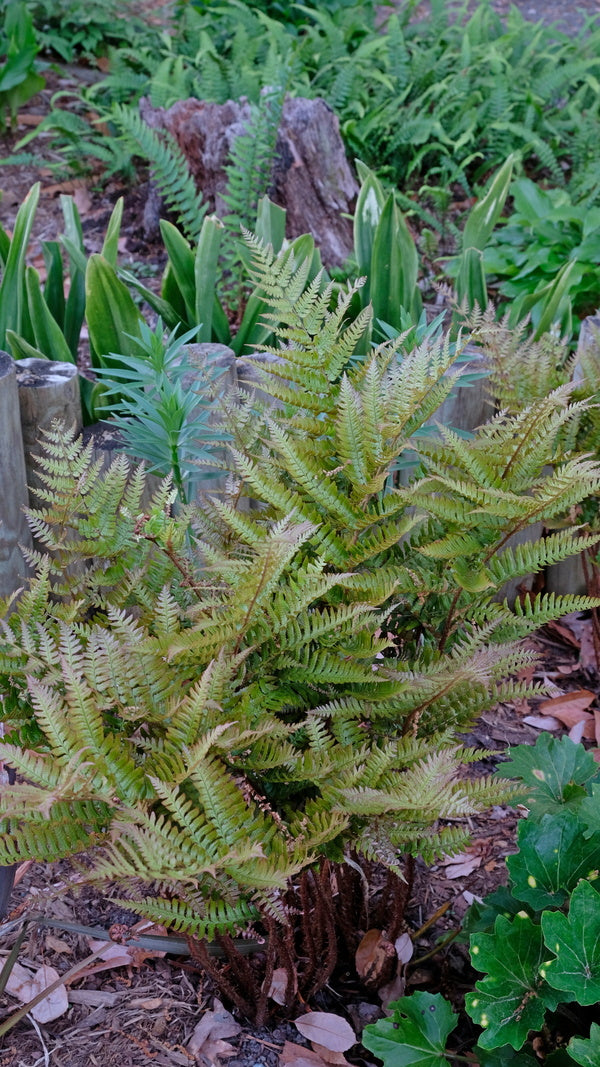
Dryopteris bissetiana
Dryopteris bissetiana (Beaded Wood Fern)
We recently revisited our identifications on our entire fern collection and found that much of what we thought we knew and much of what we had been told about the members of the Dryopteris varia complex were incorrect! Luckily, what we have always called D. bissetiana was actually that species. Many other Dryopteris which we had received under different names were found to actually represent this species as well, including all of our collections of what was thought to be Dryopteris varia. Long story short, we had a mess and now have some clarity. In any case Beaded Wood Fern, like other members of the closely related Dryopteris section Variae have the lowest-most pinnae longer than the others leading to a strange looking base. This easy-to-grow evergreen Asian species is native to moist, wooded slopes is composed of triangular, dark green fronds with a unique beaded appearance on the top which is the result of the abundant and large round sori on the underside of the leaf which result in a bump on the upper surface where they are recessed. Don't get alarmed in spring waiting for Dryotperis bissetiana to start growing, since the new foliage will not occur until June or July. (Zones 5a-8b)
Dryopteris cambrensis
Dryopteris blandfordii var. nigrosquamosa (Black-scale Blandford’s Wood Fern)
Dryopteris blandfordii is a wide-ranging species in eastern Asia. Our Black-scale Blandford’s Wood Fern is from a Hans Hansen collection from 2003 in Sichuan. This plant has proven to be a lovely tardily deciduous fern with elongate, spreading fronds of medium green reaching 2.5’ in length or more. The stipes (stems) are often dark purplish or black. This is a great fern where you want to enjoy its boldness during the growing season but allow more a more open, spacious feeling during the winter after its fronds have died back. (Zones 6a-8b, at least)
Dryopteris cambrensis (Cambrensis Log Fern) aka: Dryopteris affinis ssp. stillupensis.
Centered in Poland and the Czech Republic, Dryopteris cambrensis is a triploid evolutionary derivative of the more widespread, diploid European Dryopteris affinis. Cambrensis Log Fern, recently elevated to species status, has been a superb grower in our hot, humid summers for well over a decade, forming a stunningly elegant 30" tall x 3' wide solitary evergreen specimen. For us, it has proven tolerant in average garden soils from slightly acidic to slightly alkaline. (Zones 5a-8b, at least)
Dryopteris carthusiana
Dryopteris carthusiana (Spine Fern) (syn Dryopteris spinulosa)
Dryopteris carthusiana can be found in swamps and moist woodlands around the world. With a range that large, Dryopteris carthusiana has amazing climatic adaptability. The lacy, fine textured, arching vibrant green fronds can reach 2-3' long, forming an easy-to-grow, 3' wide, tardily deciduous clump. We grow several clones successfully here that range in provenance from Ontario to North Carolina. Our favorite clone is one received from the late Larry Mellichamp from his Gaston County, NC collection. (Zones 3a -9b)
Dryopteris x celsa
Dryopteris x celsa (Log Fern)
This species is very rare in the wild but extremely easy to grow. This native was initially derived from a naturally occurring hybrid between Dryopteris ludoviciana and Dryopteris goldiana. Though it is not common anywhere, it occurs in widely scattered locations from New York and Michigan south to the Carolina coastal plain. The growth habit is an upright, with large, coarse, dark green, 1' wide semi-evergreen fronds that are wider than D. goldiana but not as slender as D. ludoviciana. Dryopteris celsa eventually makes a slowly expanding 3’ tall clump. Although Log Fern is very tolerant of dry sites, a nice damp piece of ground will produce really spectacular results. This is one of the best ferns for Southern shade gardens and, though eventually deciduous, the leaves maintain their green color through most and sometimes all of winter though they often lose their upright nature and fall to the ground over winter. (Zones 5a-9b)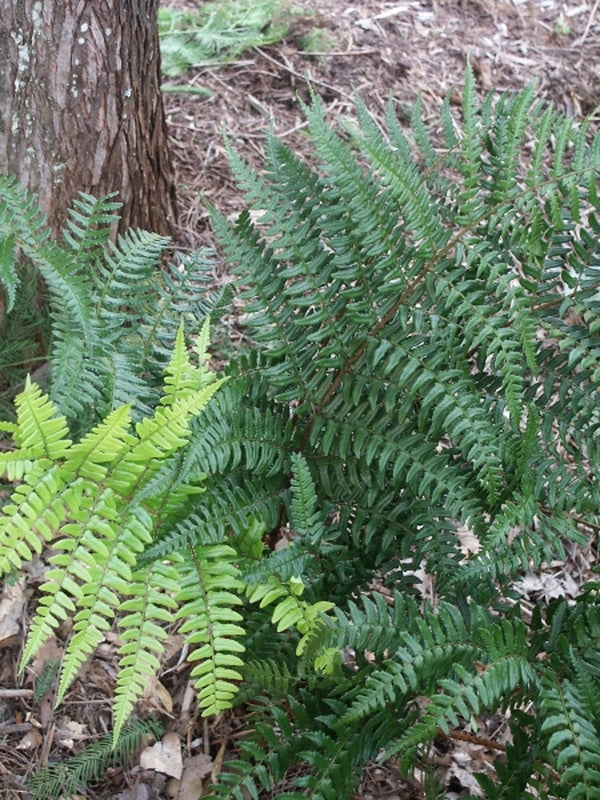
Dryopteris championii
Dryopteris championii (Champion’s Wood Fern)
Champion’s Wood Fern ranges through much of China, Korea, Japan, and Taiwan and with such a large range you would expect it to be highly adaptable and indeed it is. Dr. John Mickel describes Dryopteris championii as "another of my favorite ferns." We whole heartedly agree, few ferns can match the presence and unique boldness of this fern. This vigorous clump-former has dark green, glossy, arching fronds that can reach nearly 3' long. Not only is Dryopteris championii evergreen, but the old fronds remain upright throughout the winter months... all bets are off if you have too much winter precipitation! (Zones 5a-8b)
Dryopteris commixta (Mixed Woodfern)
We’re betting you’ve never seen this one in a garden. We only positively identified this species in the autumn of 2022. This remarkable Chinese species was received as wild-collected spore from a Darrell Probst collection in 2000. The plants produce a single crown with a whorl of beautiful, plume-shaped, dark green evergreen fronds which are pinnately compound with shallowly lobed pinnules. The stipe base is very scaly, particularly when fronds unfurl in the spring. The plants appear very adaptable to our climate and thrive in a typical woodland garden setting. (Zones 7a-8b, guessing)
Dryopteris × complexa (Complex Wood Fern) (aka Dryopteris filix mas 'Undulata Robusta', Dryopteris × tavelii)
This naturally occurring hybrid (Dryopteris affinis × Dryopteris filix-mas) is native to Eurasia. This vigorous clumper makes a 3' wide semi-deciduous mound that is quite drought tolerant once established. In the woodland garden, the moderately lacy texture of the complex male fern can be used as a superb background to hostas. (Zones 4a-8b)
Dryopteris × complexa 'Stableri' (Stabler’s Complex Wood Fern)
This selection of the popular and easy-to-grow hybrid Dryopteris × complexa makes a 3' tall, erect semi-evergreen specimen plant, similar to Dryopteris 'Barnesii'. The 3" narrow fronds of Stabler’s complex male fern make a nice vertical element for the woodland garden. (Zones 4a-8b)
Dryopteris crassirhizoma
Dryopteris × complexa 'Stableri Crisped' (Stabler’s Crisped Complex Wood Fern)
This easy to grow selection of the semi-evergreen hybrid male fern (Dryopteris affinis × filix-mas) is prized for its narrow medium green fronds of crinkled green leaves on 2' long blades. Stabler’s Crisped Complex Wood Fern is best used in small groupings for best effect. (Zones 4a-8b)
Dryopteris crassirhizoma (syn Dryopteris buschiana) (Large Rhizome Wood Fern)
This handsome, tall, vase-shaped fern usually forms a solitary upright aboveground rhizome and can reach 3'+ when happy — like a mini tree fern! It ranges from eastern Siberia, Japan, and Korea through China. The semi-evergreen, thick textured fronds give a very tropical appearance in the garden. In winter the fronds of Dryopteris crassirhizoma remain green but lay flat on the ground, helping to protect those nearby from the ravages of winter. (Zones 5a-8b)
Dryopteris cristata (Crested Wood Fern)
The Crested Wood Fern is typically thought of as a northern bog species but there are isolated populations in the piedmont and coastal plain of the Southeast, including a disjunct location in Wake County. The Wake County site is the origin of plants we have successfully grown for years that were provided by local naturalist Jesse Perry. Our plants produce narrow, strictly upright, dark green, evergreen fronds up to 3’ long. The southern clones are worthy of inclusion in the woodland garden but can also tolerate a considerable amount of light if you have a boggy or evenly moist location. (Zones 3a-8b)
Dryopteris cycadina
Dryopteris cycadina (Shaggy Shield Fern) (aka Dryopteris atrata)
This is a wide-ranging species from eastern and southern Asia. It is a medium-sized, semi-evergreen Chinese fern is a distinctive addition to the woodland garden with its very dark green, heavily textured foliage and black stipe which is densely covered with slender black scales. When Dryopteris cycadina emerges in spring, all of our visitors comment on its beauty. (Zones 5a-8b)
Dryopteris decipiens
Dryopteris decipiens (Deceptive Wood Fern)
Dryopteris decipiens has rapidly become one of our favorite garden ferns. The 1' tall x 26" wide clump has 15" long handsome evergreen fronds and is simply elegant in the garden, especially when the red-flushed new growth emerges in spring. Deceptive Wood Fern hails from subtropical evergreen forests in South Central China and into Japan but is much more winter hardy than its origins would indicate. (Zones 6a-8b, guessing)
Dryopteris dickinsii (Dickins Wood Fern)
Now here is a very unique Dryopteris that looks a bit more like a glade fern or deciduous Polystichum. Despite its widespread native habitat from India to Taiwan, where it can be found along watercourses at elevations between 3,000’ and 8,000’, Dryopteris dickinsii is rarely seen in gardens. For us, it has proven amazingly easy in cultivation under a wide range of conditions. The solitary 15” tall x 2’ wide rosette of evergreen foliage is composed of delightfully vibrant green, thin, pinnate laminas. Similar to Dryopteris namegatae but the scales on the stipe are brown to pale brown. (Zones 7a-8b, at least)
Dryopteris dilatata 'Grandiceps' (Grandiceps Crested Wood Fern)
This easy-to-grow deciduous clumper has always been one of our favorite ferns in the garden with the 2-3' long arching fronds each ending in a large petticoat-like crest. Each 2-3' wide clump of Dryopteris ‘Grandiceps’ makes a stunning specimen plant. (Zones 4a-8b)
Dryopteris dilatata 'Jimmy Dyce' (Jimmy Dyce Wood Fern)
This selection of the deciduous Dryopteris dilatata was made in 1969 on a fern expedition to the Isle of Arran by fern guru Jimmy Dyce, and later named in his honor. This shorter-than-normal clone has broad, rich-green foliage and a very upright, arching growth habit to 1' tall by 1' wide... larger in the PNW. (Zones 5a-8b)
Dryopteris erythrosora
Dryopteris erythrosora (Autumn Fern)
This is everyone's favorite evergreen fern with its 2' long, very dark green triangular fronds and striking new foliage of red and bronze. We love scattering the 2’ tall x 2’ wide Dryopteris erythrosora throughout the woodland garden as a background for hostas and other bold-textured woodland plants. (Zones 5a-9b)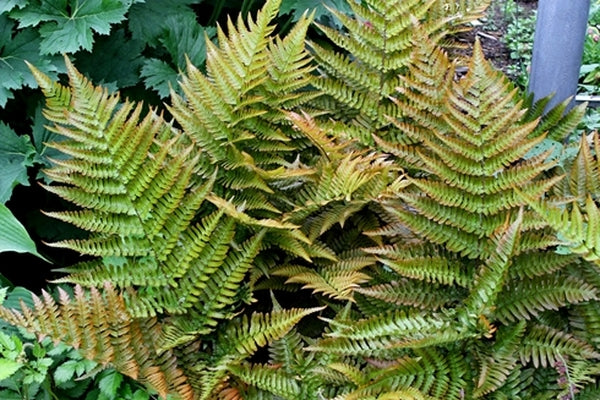
Dryopteris erythrosora 'Brilliance'
Dryopteris erythrosora 'Brilliance' (Brilliance Autumn Fern)
This selection of Autumn Fern has brighter red new growth than what is typically seen with spore-grown plants. Frankly, all Autumn Ferns have great color when the new fronds emerge from the evergreen clump, so Dryopteris erythrosora ‘Brilliance’ is really something special. Brilliance Autumn Fern is a very easy-to-grow fern making a 2' wide clump that is tolerant of a wide range of garden conditions, including extreme drought, once established. (Zones 5a-9b)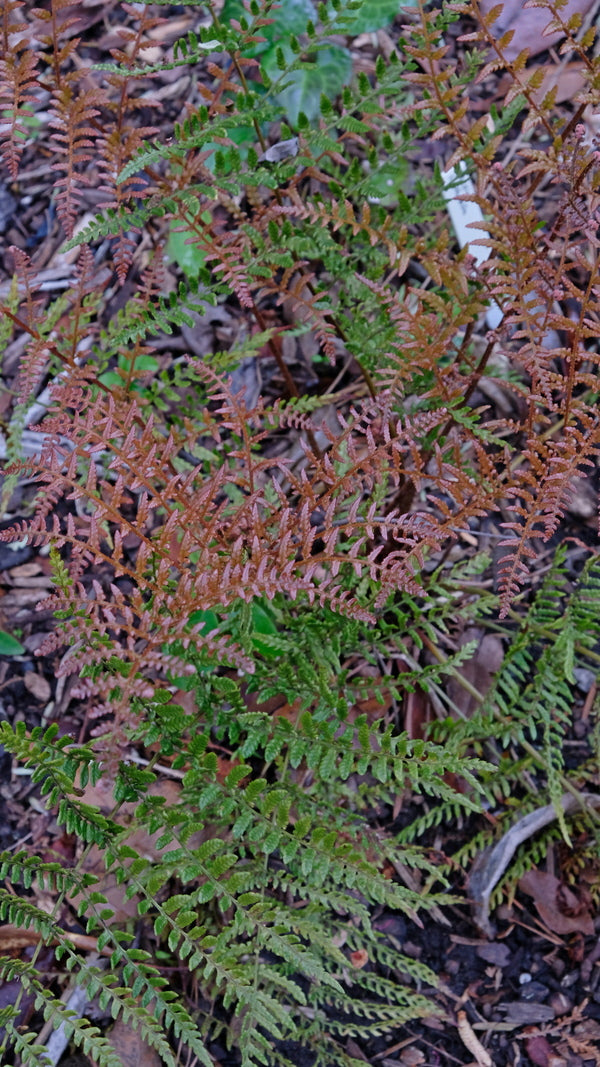
Dryopteris erythrosora var. prolifica
Dryopteris erythrosora var. prolifica (Lacy Autumn Fern)
This unique fern is a lacy leaf form of the easy-to-grow and popular Autumn Fern. Each 1' tall drought-tolerant evergreen clump boasts lacily cut, dark green foliage that emerges cinnamon-red throughout the growing season. In humid climates, the fronds will produce new plantlets along the edges of the leaves... very cool! You'll love the texture of Dryopteris erythrosora var. prolifica as you weave these into the woodland garden. (Zones 5a-9b)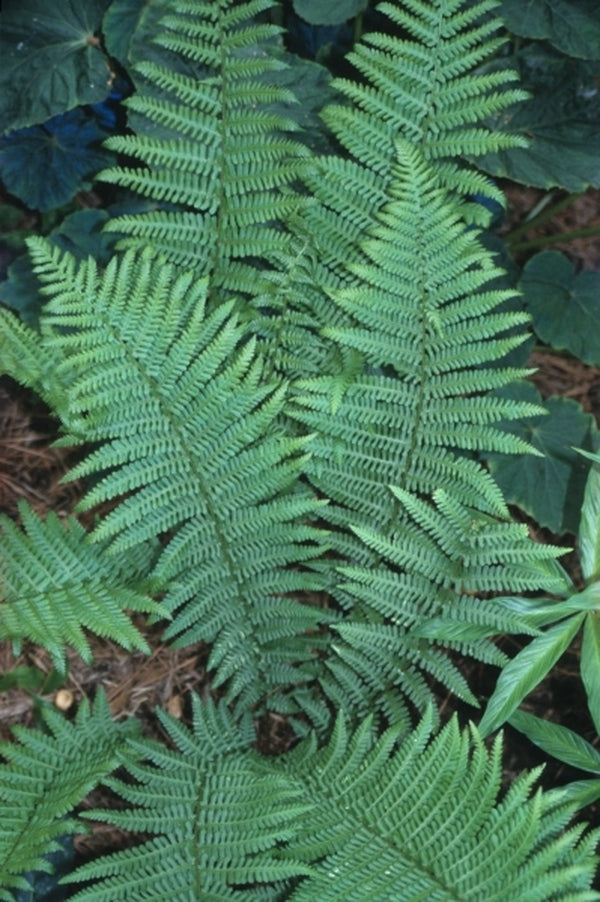
Dryopteris filix-mas
Dryopteris filix-mas (Male Fern)
This native, to both the US and Europe, makes an attractive, easy-to-grow deciduous clump to 2' tall by 3' wide. Dryopteris filix-mas prefers a cool, moist woodland site and should be protected from extreme heat in the South. (Hardiness Zone 4a-8b)
Dryopteris filix-mas 'Barnesii'
Dryopteris filix-mas 'Barnesii' (Barnes Male Fern)
This selection of the deciduous Male Fern was selected for its very narrow fronds, upright growth habit, square pinnules (green segments that make up the leaf) and ease of growth. Barnes male fern grows equally as well in acid or slightly alkaline soils. (Zones 4a-8b)
Dryopteris filix-mas 'Cristata Jackson' (Jackson’s Cristate Male Fern)
This is an exquisite and fast-growing form of the deciduous native male fern. Dryopteris 'Cristata Jackson' takes each fern frond and end it with a bushy afro like terminal crest. Smaller crests are found up and down the leaf on the end of each pinnae. Dryopteris filix-mas ‘Cristata Jackson’ makes a 2-3' wide clump. (Zones 4-8)
Dryopteris filix-mas 'Cristata 'Martindale' (Martindale’s Cristate Male Fern)
This selection of easy-to-grow deciduous male fern, discovered during the Victorian fern craze, is composed of standard fern fronds (if such exist), each ending in tiny little crests. The 2-3' wide clumps of Dryopteris ‘Cristata Martindale’ make a stunning accent for hostas and lighter foliage accents in the moist woodland garden. (Zones 4-8)
Dryopteris filix-mas 'Linearis Congesta' (Congested Linear Male Fern)
This English selection of the deciduous male fern is the perfect choice for the shady rock garden. The rigidly upright dark green fronds of Dryopteris filix-mas ‘Linearis Congesta’ are clothed with narrow pinnae that curl downward giving a very congested appearance. The dwarf slender male fern also makes a great companion for a variety of lonely lady ferns. (Zones 4-8)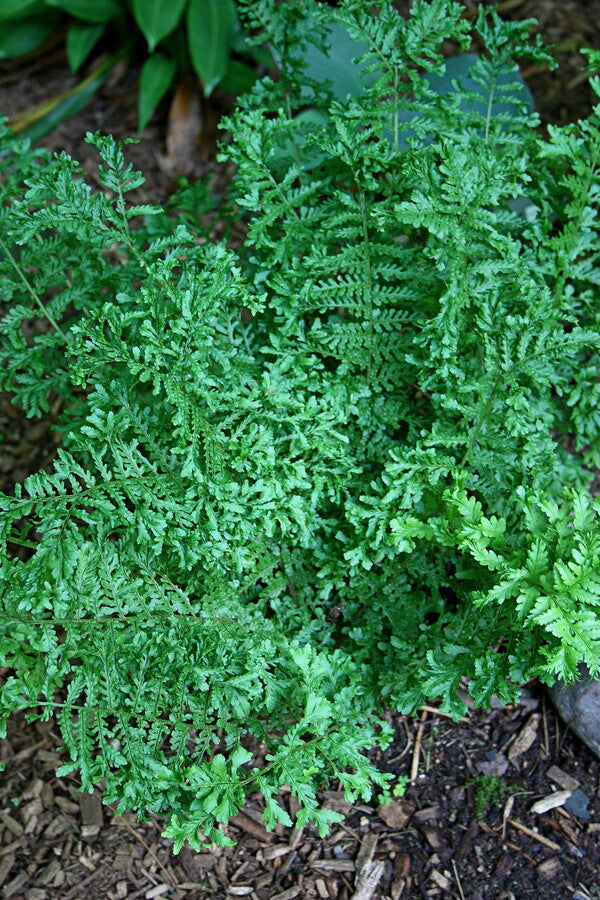
Dryopteris filix-mas 'Linearis Polydactyla'
Dryopteris filix-mas 'Linearis Polydactyla' (Crested Linear Male Fern)
Dryopteris filix-mas ‘Linearis Polydactyla’ is an open-growing, deciduous fern produces 30" fronds with an airy texture. At the end of each leaf is a forked pinnule...it splits in two. Each leaf along the stem also ends in a cute little petticoat. Crested linear male fern is a darling mingler, best when blended with other woodland inhabitants. (Zones 4-8)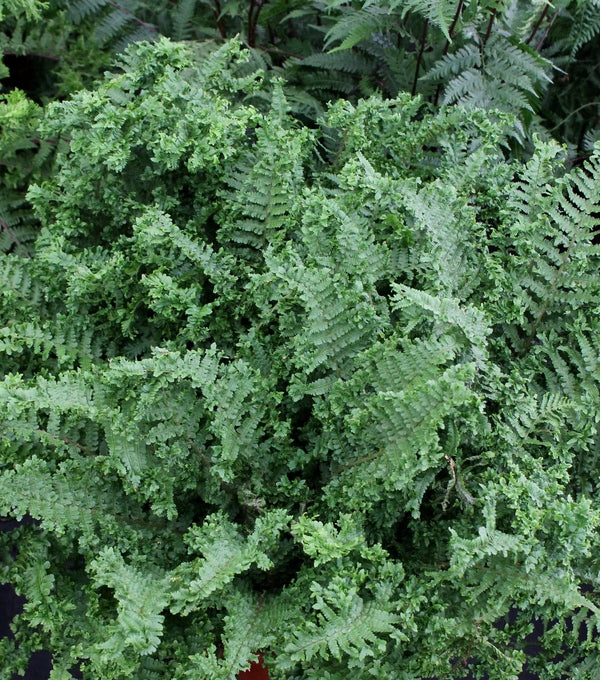
Dryopteris filix-mas 'Parsley'
Dryopteris filix-mas 'Parsley' (Parsley Male Fern)
This new introduction was discovered in the US as a sporeling with a particularly congested form and occasional crinkled fronds. When fully grown, expect Dryopteris filix-mas ‘Parsley’ to make a 18" tall by 2' wide deciduous clump. (Zones 4a-8b)
Dryopteris formosana
Dryopteris formosana (Formosa Wood Fern)
This Asian native makes an attractive, easy-to-grow, 18" tall by 30" wide evergreen clump. The airy-textured, 2' long, deep green fronds of Dryopteris formosana widen considerably at the base where the last set of pinnules turns downward. This unique symmetry as well as the strictly upright leaves make this an attractive specimen that stands out among other ferns. (Zones 6a-9b, at least)
Dryopteris formosana ‘Yushan 2 X 4’ (2 X 4 Formosa Wood Fern)
It was hard for us to assign this peculiar small evergreen fern with nearly pentagonal fronds to a species until our taxonomist, Zac Hill discovered a paper that detailed the sexually reproducing diploid forms and apogamous triploid forms of this species. A triploid results from a crossing of a regular diploid with a tetraploid and thus a diploid (2) X tetraploid (4). Aside from its unusual chromosome number this beautiful fern makes 1’ tall fronds that are held at a spreading angle from the stipe and are dark green and glossy. It is a beautiful addition to any woodland garden. (Zones 6a-9b, at least)
Dryopteris goldieana
Dryopteris goldiana (Goldie’s Wood Fern)
A stunning eastern US native (Minnesota south to Alabama), Dryopteris goldiana has very wide, spreading, dark green fronds. The shaggy brown fiddleheads unfurl in spring to transform into fronds up to 4’ long. Dryopteris goldiana makes a spectacular clump in a moist, acidic woodland garden, albeit is also quite drought tolerant when the need arises. Though it survives in our hot, humid summers it is best in zones with cooler nighttime temperatures. (Zones 3a-8a)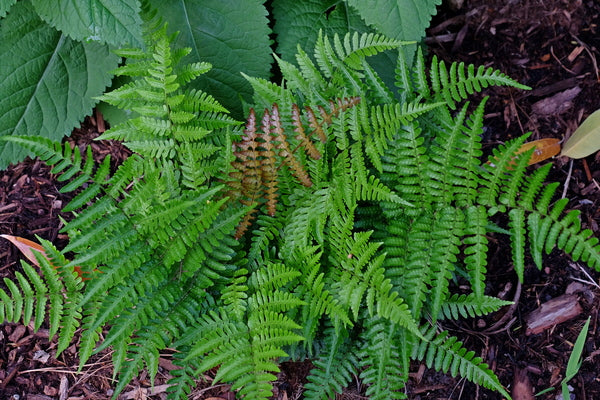
Dryopteris hondoensis
Dryopteris hondoensis (Hondo Wood Fern)
Thanks for Dr. John Mickel for introducing this evergreen fern species from the moist woodlands of Japan into cultivation in the US. This very cool fern has lacily cut foliage similar to Dryopteris erythrosora on a vigorous growing 3' wide clump. Also, like Dryopteris erythrosora, the new growth of Dryopteris hondoensis is a striking red color. The airy fronds make a great textural feature in the woodland garden. Dryopteris hondoensis is an apogamous triploid, meaning it can satisfy its' own sexual urges without a consummating encounter...and it has an extra set of chromosomes. For botanists, that's reason alone to own this oddity, but as a horticulturist, it forms an amazing garden specimen. (Zones 5a-9b, at least)
Dryopteris indusiata
Dryopteris indusiata (Indusia Wood Fern)
This little-known and little-grown evergreen Chinese and Japanese native has proven to be a very good and tough addition to the woodland garden. In 9 years, our clumps of Dryopteris indusiata were 18" tall by 30" wide with very sturdy, dark-green fronds. (Zones 6a-8b at least)
Dryopteris intermedia (Intermediate Wood Fern)
Intermediate Wood Fern is a wonderful semi-evergreen US native fern found in mountainous regions from Canada south to Alabama. The 2' long fronds of Dryopteris intermedia compose a 3' wide by 18" tall clump from a solitary base that loves to grow in moist woodland gardens. It is particularly well suited for cooler climates but tolerates the heat and humidity of the piedmont when situated in a shady cool microclimate in rich, organic soils. (Zones 3a-8b)
Dryopteris juxtaposita (Juxtaposed Wood Fern)
What a great name and a great plant to match! This tall, semi-evergreen fern hails from eastern Asia found from India, Thailand, and Vietnam, north through southern China. We have been impressed with its performance in our woodland garden where it forms well behaved clumps with 3’ long evergreen leaves. Almost never seen in gardens. (Zones 7a-8b. guessing)
Dryopteris kinkiensis 'Green Hans'
Dryopteris kinkiensis (Kinki Asian Wood Fern)
Dryopteris kinkiensis (love the name) is a little-known, semi-evergreen Asian fern that has become one of our favorite ferns in the garden. Dryopteris kinkiensis is related to Dryopteris championii and forms a stunning clump, composed of very wide dark green fronds. Although slow-growing, Dryopteris kinkiensis is quite easy to grow when planted in an evenly moist soil, eventually forming a 2' tall x 2' wide deer-resistant clump. Our plants are spore-propagated from original spore collected by Hans Hansen in Guizhou, China. (Zones 7a-9b, guessing)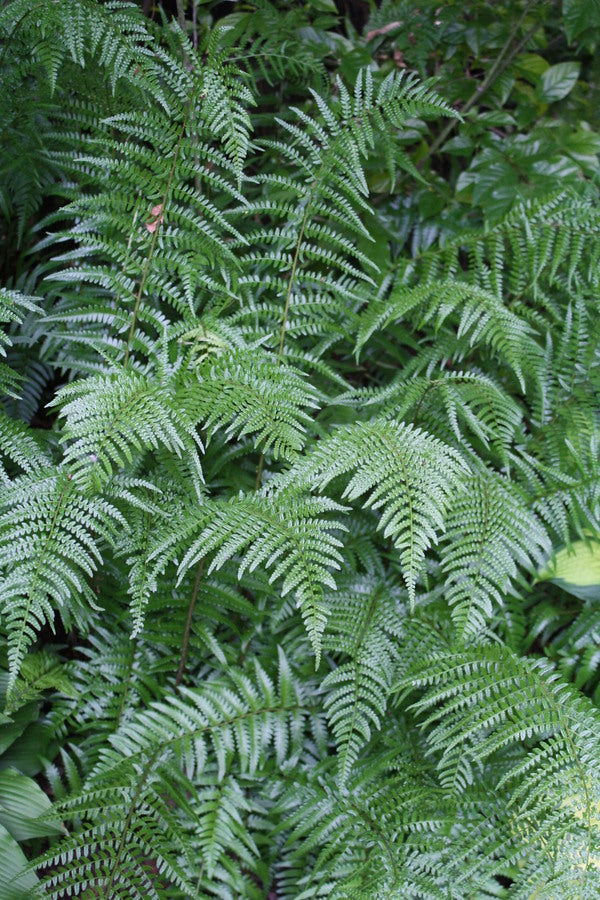
Dryopteris ludoviciana
Dryopteris ludoviciana (Southern Shield Fern)
Southern Shield Fern is a stately, semi-evergreen clumping fern, native to southeastern US, makes a wonderful addition to the woodland garden. The shiny but leathery 3' tall fronds of Southern Shield Fern form a striking upright architectural specimen in the garden. Despite being native to swamps, Dryopteris ludoviciana has performed admirably for us in normal garden conditions. (Zones 6b-9b, possibly colder)
Dryopteris marginalis
Dryopteris marginalis (Marginal Wood Fern)
Marginal Wood Fern is a superb, easy-to-grow, but overlooked, native fern that should be in every woodland garden. From Maine west to Oklahoma and south to Georgia, Dryopteris marginalis can be found on rocky woodland slopes. Dryopteris marginalis typically makes a compact 18" tall by 2' wide, evergreen, vase-shaped clump. (Zones 3a-8b)
Dryopteris marginalis 'Franklinstein'
Dryopteris marginalis 'Franklinstein' (Franklinstein Marginal Wood Fern) (aka A2VA-034)
We found this dwarf, compact form of Dryopteris marginalis in 2001, growing on a very rocky slope near the town of Franklin in Pendleton Co., West Virginia. In our garden, this easy-to-grow drought-tolerant fern has maintained the dwarf habit, forming a 14" tall by 20" wide clump. (Zones 3a-8b)
Dryopteris monticola (Asian Mountain Wood Fern)
Asian Mountain Woodfern is a handsome, medium-sized, evergreen fern from a solitary base resembling a robust Marginal Wood Fern in habit. It has proven adaptable and tolerant of our summers in cool microclimates here in central NC. It is native mountainous areas in Korea, Japan, and northern China. (Zones 6a-8b, guessing)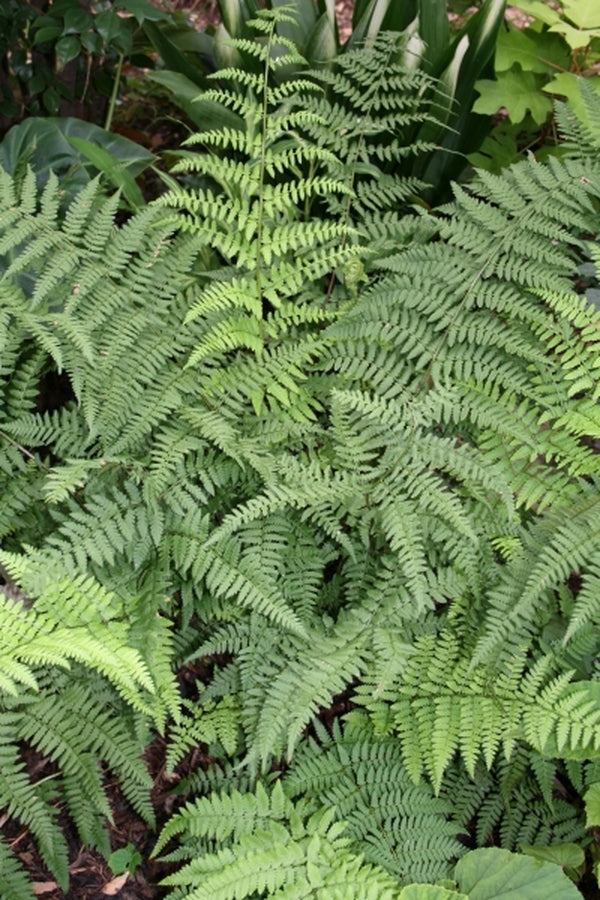
Dryopteris munchii
Dryopteris munchii (Mexican Snack Fern)
We have been unable to determine the proper immigration status of Dryopteris munchii, but since it has now had babies in the US, this native of 6,500'-8,500' in southern Mexico is in our garden to stay. The arching 2' fronds make a superb 3' wide evergreen specimen clump in the woodland garden. While we grow over 1,000 different ferns, Dryopteris munchii has certainly become one of our favorites. Despite its common name, Dryopteris munchii is still deer resistant. (Zones 7b-9b, at least)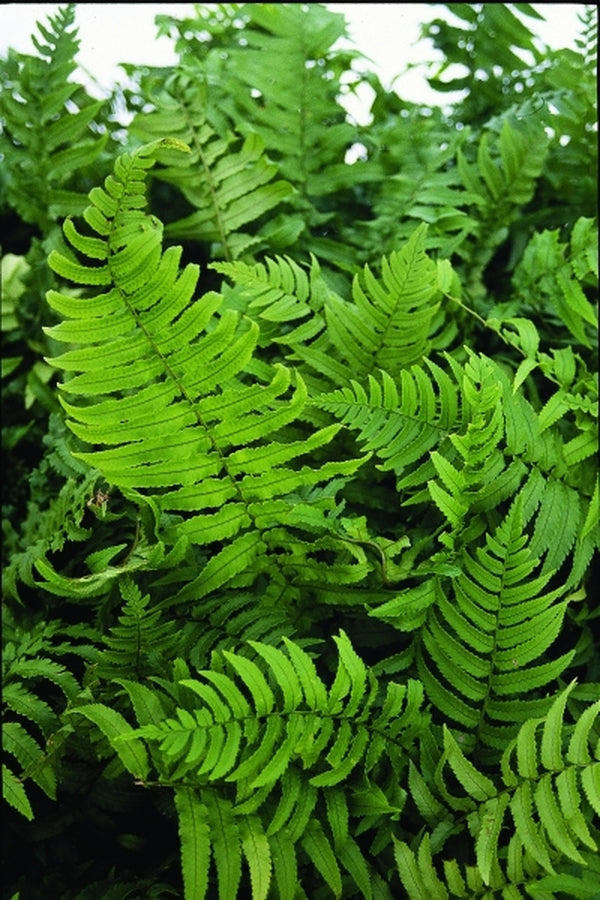
Dryopteris namegatae
Dryopteris namegatae (Namagatae Wood Fern)
This is a beautiful Japanese fern that is similar to D. dickinsii but has numerous scales on stipe that are black and linear-lanceolate. Like Dickin’s Wood Fern, this species looks more like a glade fern or thin-leaved Polystichum than a Dryopteris. (Zones 6a-9b, guessing)
Dryopteris nipponensis
Dryopteris nipponensis (Wide-leaf Autumn Fern) (syn Dryopteris cystolepidota)
This stunning cousin of the popular autumn fern makes a 2' wide by 2' tall evergreen clump with foliage that is shorter, but broader, than Dryopteris erythrosora. The unique foliage texture of Dryopteris nipponensis makes this a favorite of garden visitors. The new growth in spring is tinted red for a wonderful contrast. Dryopteris nipponensis is easy to grow in typical woodland garden conditions...moist or dry. (Zones 6a-9b, possibly colder)
Dryopteris pallida (Pale Mediterranean Wood Fern)
The little-known Dryopteris pallida is from our spore collections from 2700' elevation near the town of Omalos in Western Crete's Chania Prefecture. Dryopteris pallida 'Omalos' is a cute Mediterranean wood fern that has thrived in our non-Mediterranean climate, forming a small 8" tall x 16" wide evergreen clump...perfect for the woodland rock garden. (Zones 7b-9b, at least)
Dryopteris pseudo-filix-mas (Mexican Male Fern)
Dryopteris pseudo-filix-mas is similar to Dryopteris wallichiana, but larger, Dryopteris pseudo-filix-mas hails from the high moist mountain forests in Mexico and Guatemala where it is quite rare. Unlike most other male ferns, the Mexican Male Fern continues to produce new fronds all season instead of just a single spring flush. Finally, as fall approaches, Dryopteris filix-mas retires for the winter, but the semi-evergreen fronds already produced will remain until spring. (Zones 5a-8b)
Dryopteris commixta
Dryopteris pycnopteroides (Pycnopteroides Wood Fern)
This easy-to-grow, evergreen clump-forming fern from Japan has very shiny, green erect fronds to 2' in length. Dryopteris pycnopteroides is in a word…stunning. The stiffly upright stipes are covered with black hairs, which add to its beauty. (Zones 6a-8b)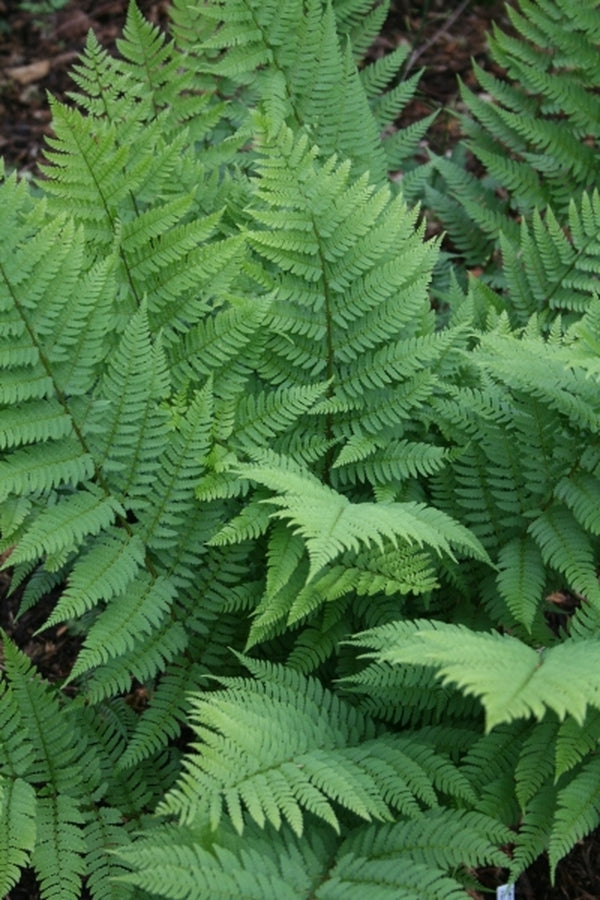
Dryopteris x separabilis
Dryopteris × separabilis (Separate Wood Fern)
This rare NC native (and just over the border in Virginia) is a naturally-occurring hybrid between Dryopteris celsa and Dryopteris intermedia. In the garden, Dryopteris x separabilis forms a robust, 30" tall by 30" wide clump of wide, rich medium green, glossy, strongly-upright leaves. In late winter, the leaves, settle to the ground. In the wild, Dryopteris × separabilis grows well above but still near swampy habitats. (Zones 5a-9b guessing)
Dryopteris sieboldii
Dryopteris sieboldii (Siebold’s Wood Fern)
This easy-to-grow, drought-tolerant fern is also one of the most unique ferns that we grow...the bold-textured, cardboard-like leaves resemble giant hands. The tropical-looking, 2' wide clumps of Dryopteris sieboldii remain evergreen down to 5ºF. (Zones 7b-10, possibly colder)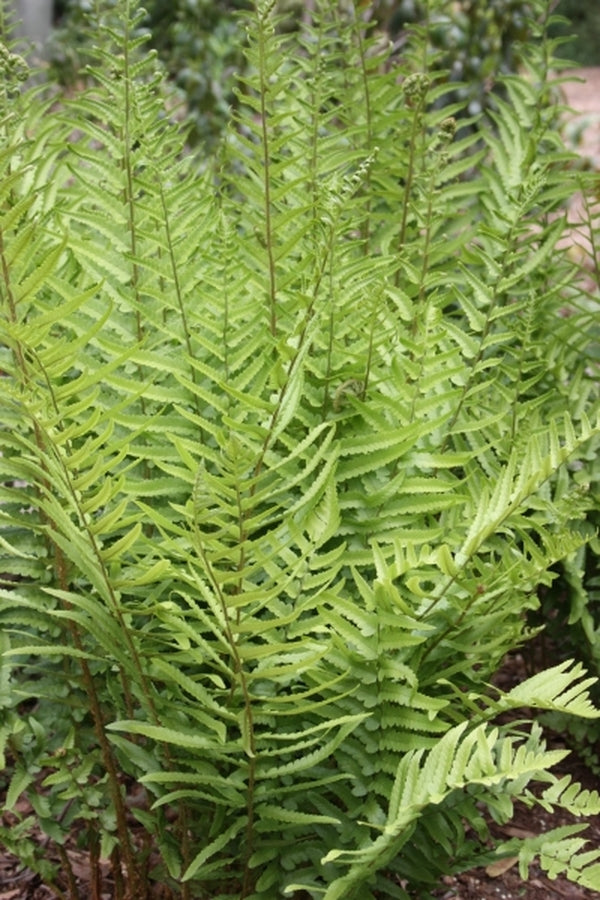
Dryopteris tokyoensis
Dryopteris tokyoensis (Tokyo Wood Fern)
The Tokyo Wood Fern is one of those little-known but very easy-to-grow deciduous woodland ferns, native to woodlands from Honshu to Shikoku and across to Korea. The tight clump of upright, narrow, 2' long fronds provides a splendid vertical accent in the woodland garden. Dryopteris tokyoensis is easily recognizable in the garden from all other ferns we grow. (Zones 5a-8b, possibly colder)
Dryopteris wallichiana (Wallich’s Wood Fern)
Considered one of the most beautiful garden ferns, this Asian/Turkish/African/South American/Central American (whew) native has narrow, dark, glossy black green foliage, making a spectacular giant clump to 3' wide. As it is found in very high elevation areas, Dryopteris wallichiana prefers a site where a cool summer is possible. The semi-evergreen clump rarely forms offsets, so it is best used as a dramatic accent plant in the woodland garden. Unfortunately, this one has proven short-lived in our piedmont heat during the summer and is only a great plant for gardens in zones with cooler nighttime temperatures (Zones 5a-7a)
Dryopteris xanthomelas 'Sichuan'
Dryopteris xanthomelas ‘Sichuan’ (Tortoise-shell Wood Fern)
Dryopteris xanthomelas 'Sichuan' is our introduction of a Hans Hansen spore collection in Sichuan, China, where it grows between 5,000' and 8,000' elevation. The 1' tall x 20" wide evergreen clumper is composed of 18" long fronds with lovely cinnamon midribs. We have found Dryopteris xanthomelas 'Sichuan' quite easy to grow in our slightly acidic woodland. (Zones 6a-8b)

